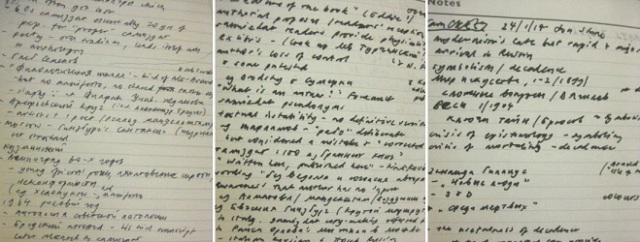The CamCREES bibliographical notes have lapsed of late, with many of the 2016 seminars missed due to trips away, but it is a pleasure to resurrect them to discuss the three seminars which the Lent Term provided – a talk on early Russian modernism and two on Soviet underground literature.

A Decadent Metaphysics: Fin-de-siècle Anxiety and the Cultural Contexts of Early Modernism (Jon Stone) — 24 January
Professor Stone spoke about modernism’s late but enormously influential arrival in Russia, examining in particular the movements of symbolism and decadence. In his talk, he “[recast] the story of early modernist literature and culture by drawing out the tension of its simultaneous engagement with the otherworldliness of symbolism and the corporeality of decadence in works of the Russian and European fin-de-siècle” (from the seminar’s precis).
Among the literary pieces which Professor Stone examined was Zinaida Gippius’ short story Sredi mertvykh (Among the dead; also called Zhivye i mertvye (The living and the dead)). The story’s heroine, Sharlotta, the daughter of a graveyard superintendant, becomes fascinated with the grave of a young man and is gradually drawn away from the land of the living. Professor Stone looked at aspects such as Gippius’ use of colour in the story to show the division between Sharlotta’s earthly life and the one she drifts into in the graveyard.

Zinaida Gippius is fairly well represented in our collections. The earliest book we have in physical form (we also hold several titles on microfilm) is her 1906 Alyi mech (Scarlet sword) collection of stories, at 757:26.c.90.54. On the title page (above), we see the subtitle “short stories” followed by “4th book” in brackets; this was the fourth book of stories which Gippius had published. It’s a nice first edition if a little hampered by lacking the last leaf of text. More recently, we have volumes 1-9 of the 15-volume Sobranie sochinenii (Collection of works; 757:26.d.200.33-41) published between 2001 and 2015, with 5 of the remaining 6 in the acquisitions pipeline. Volume 11 is currently proving hard to get, but I am hopeful that we will be able to find a copy before too long to complete the set.
The other two CamCREES seminars of the term focused on the phenomenon of samizdat, the unofficial distribution of literary works in the Soviet period. Both speakers were introduced by Dr Josephine von Zitzewitz who is in Cambridge as a Leverhulme Early Career Fellow and whose current project is ‘Leningrad Samizdat as Social and Material Culture: From Reader to Activist’.
The Function of the Author in Samizdat Text Production (Valentina Parisi) — 7 February
In her talk, Dr Parisi showed examples of “samizdat/tamizdat textual production where the author lacks control over the further reproduction and dissemination of his/her work” (from the talk’s precis). Samizdat made the passive reader active publisher, as works were reproduced as they were read, with authorial control essentially severed from the point of text’s first appearance. Tamizdat – a play on samizdat (which comes from the words “oneself” and “publisher”) and which stems from “there” (ie not the Soviet Union) and “publisher”) – saw texts properly published abroad, but again with little or no discussion with the author. Evgeniia Ginzburg’s memoir Krutoi marshrut (A harsh route (published in English normally under titles involving the word “whirlwind”)) about her time in the Gulag was one of the examples Dr Parisi spoke about. Written in parts, the text was circulated within the Soviet Union via samizdat and also published through tamizdat, first appearing in Milan in 1967 (and causing problems for Ginzburg back in Russia). The UL’s earliest copies date also from that year – a English translation at 586:94.c.95.53 and a Russian copy printed in Germany at 586:92.d.95.150. Full versions of the text come later; our Russian copy (878 pages to 1967’s 432) dates to 2010 and is at 586:94.c.200.108.

Written here, published there by Friederike Kind-Kovács was mentioned by Dr Parisi as an introduction to tamizdat; our copy is at 756:16.c.201.65. As the record for that book shows, neither samizdat nor tamizdat are terms used as subject headings. Samizdat is represented by Underground literature–Soviet Union and tamizdat by Russian literature–Publishing–Foreign countries.
Poetry’s Role in Leningrad Samizdat (Marco Sabbatini) — 21 February
Dr Sabbatini’s talk, delivered in Russian, presented “the major themes, forms and authors of Russian poetry in Leningrad samizdat during the 1950s-1980s” (from the talk’s precis). The seminar provided a rich insight into samizdat activities, from the single copies and oral tradition of the 1950s, through the 1960s (especially the “rokovoi god” (fatal year) of 1964, in which events such as Joseph Brodsky’s arrest took place (the transcript of his trial was itself then circulated via samizdat)), to the anthologies and periodicals of the 1970s and 1980s. The audience particularly enjoyed footage of Russian writers, known in the USSR only through samizdat, being interviewed during a party in the USA.
CamCREES seminars are always interesting and, for me, also provide incredibly useful pointers for our collections. Looking at what we hold by some of the writers about whom Dr Sabbatini spoke, for example, has seen three books fetched from our backlog and added to the catalogue, brought existing catalogue errors to light, and helped me identify another title to buy.
- Roal’d Mandelshtam: Stikhotvoreniia (1997; 9002.d.8775); I will also try to buy a copy of the much longer Sobranie stikhotvorenii published in 2006.
- Leonid Aronzon: 4 titles including the 2-volume Sobranie proizvedenii (2006; 756:36.c.200.65-66) and the 2015 Sto stikhotvorenii (C205.d.12)
- Viktor Krivulin: Okhota na Mamonta (1998; 757:66.d.95.169); Stikhi posle stikhov (2001; C200.d.2373)
- Elena Shvarts: 13 titles dating from 1985 (Tantsuiushchii David; 756:36.d.95.857) to 2013 (Izbrannye stikhotvoreniia; C212.c.5743)
- Sergei Stratanovskii: T’ma dnevnaia (2000; 2003.8.3154); Ozhivlenie bubna (2009; 2016.8.3879); Muddy river [translated poetry] (2016)
- Konstantin Kuz’minskii: his edited multi-volume anthology of Russian poetry (1980-1986; 756:36.c.95.64-70A)
- Oleg Okhapkin: Lampada (2010; C212.c.5742); Liubovnaia lirika (2013; 2016.9.3542); Filosofskaia lirika (2014; 2016.9.3543)

Mel Bach

